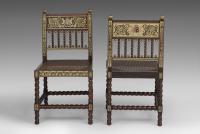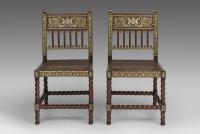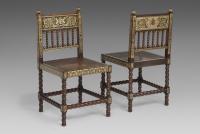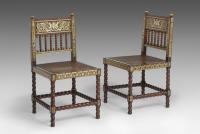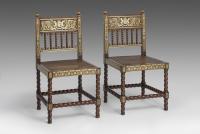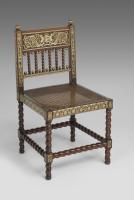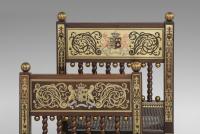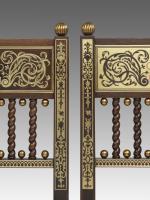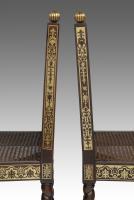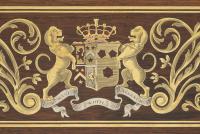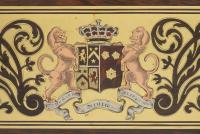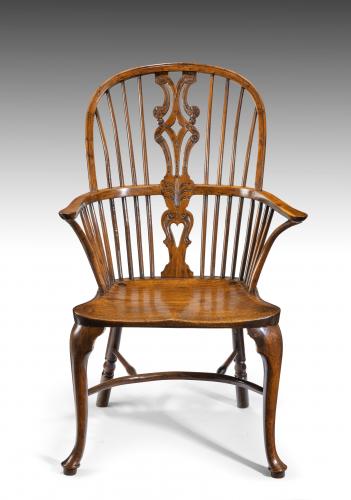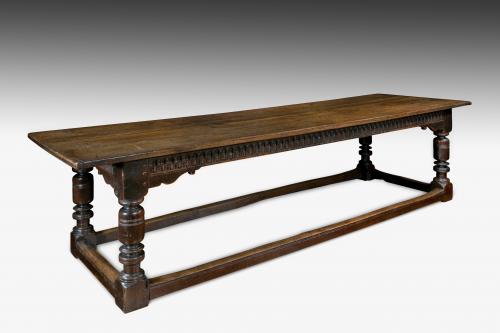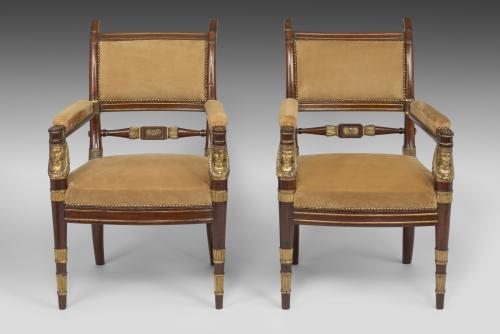
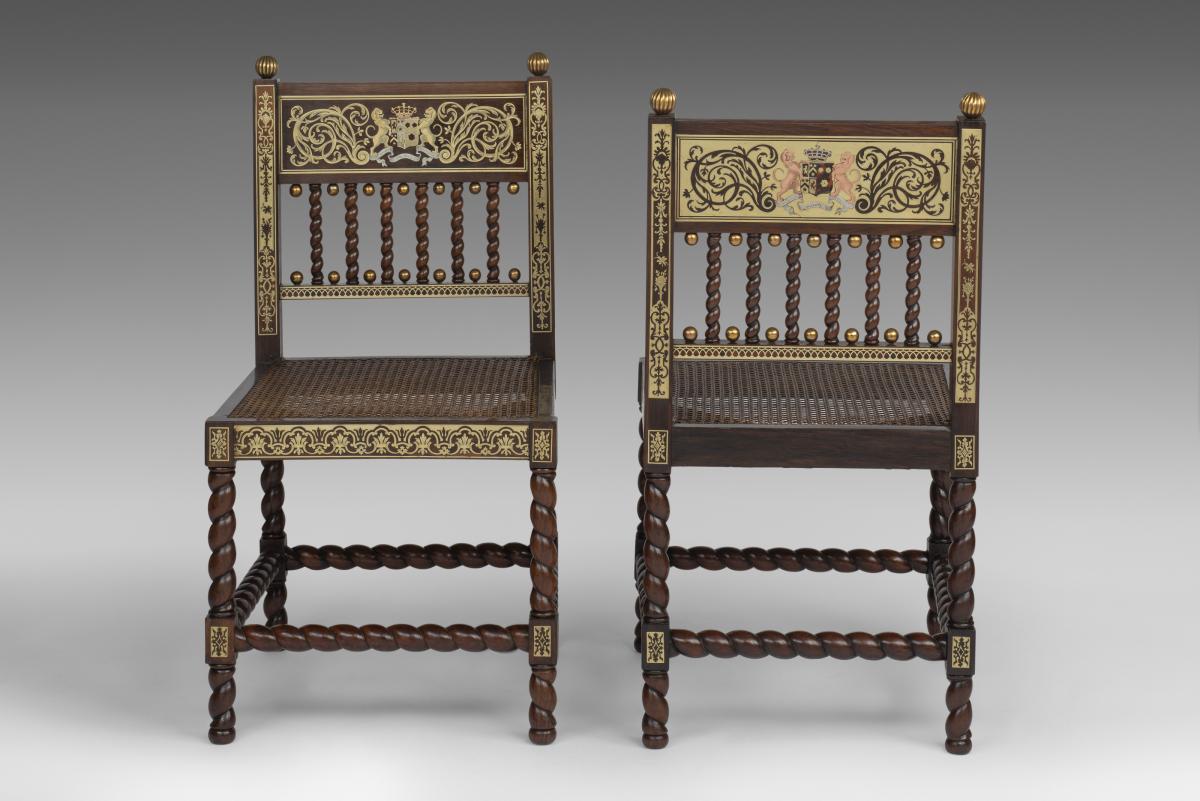
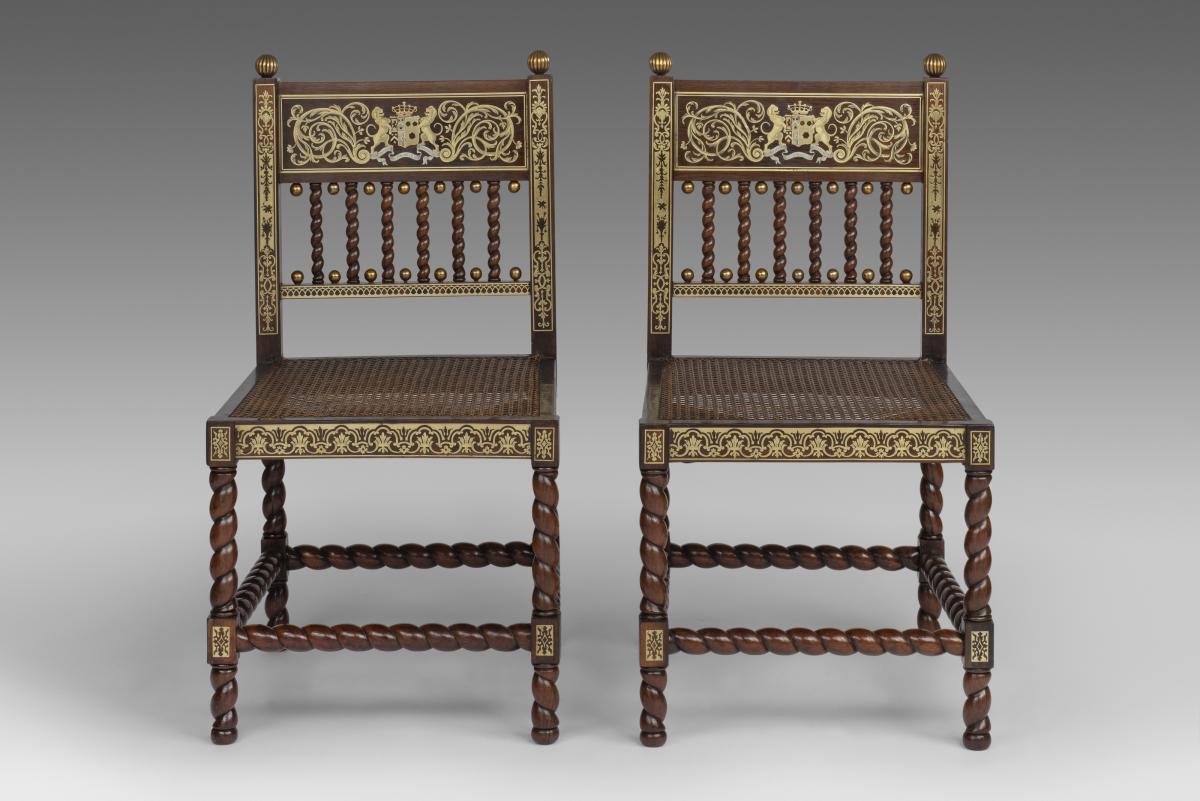
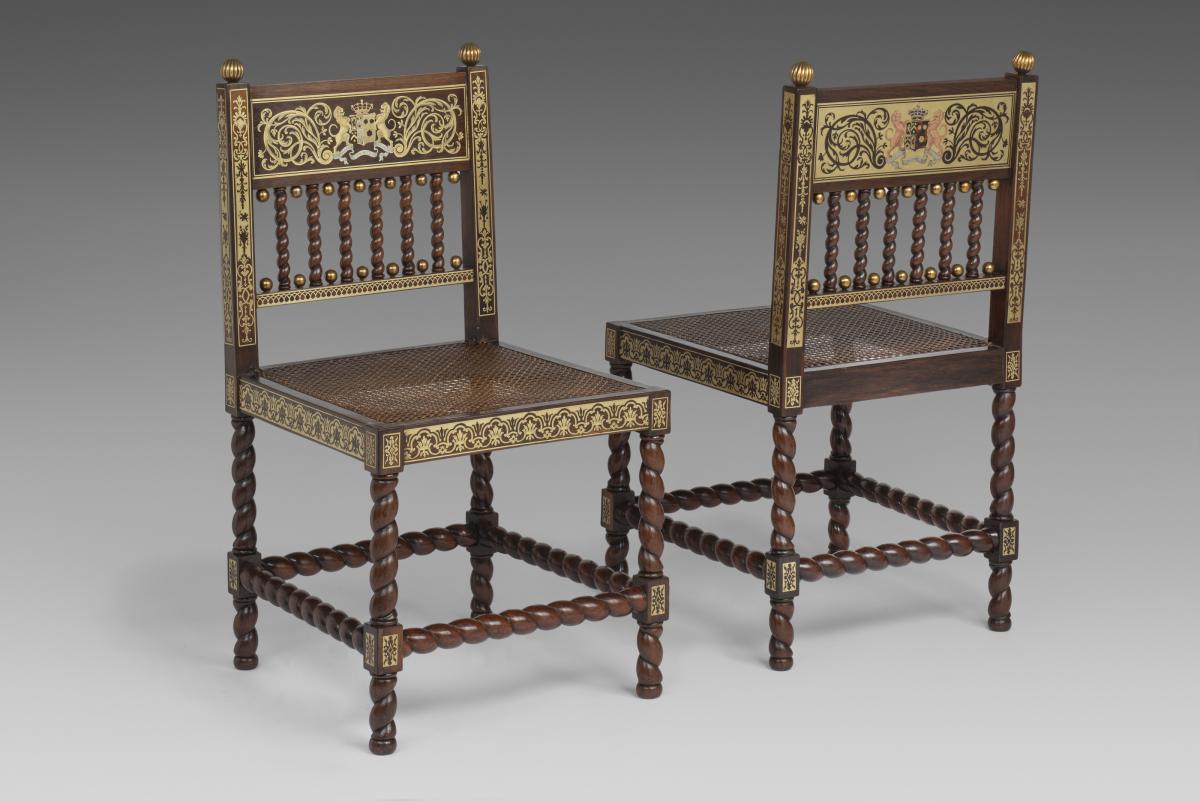
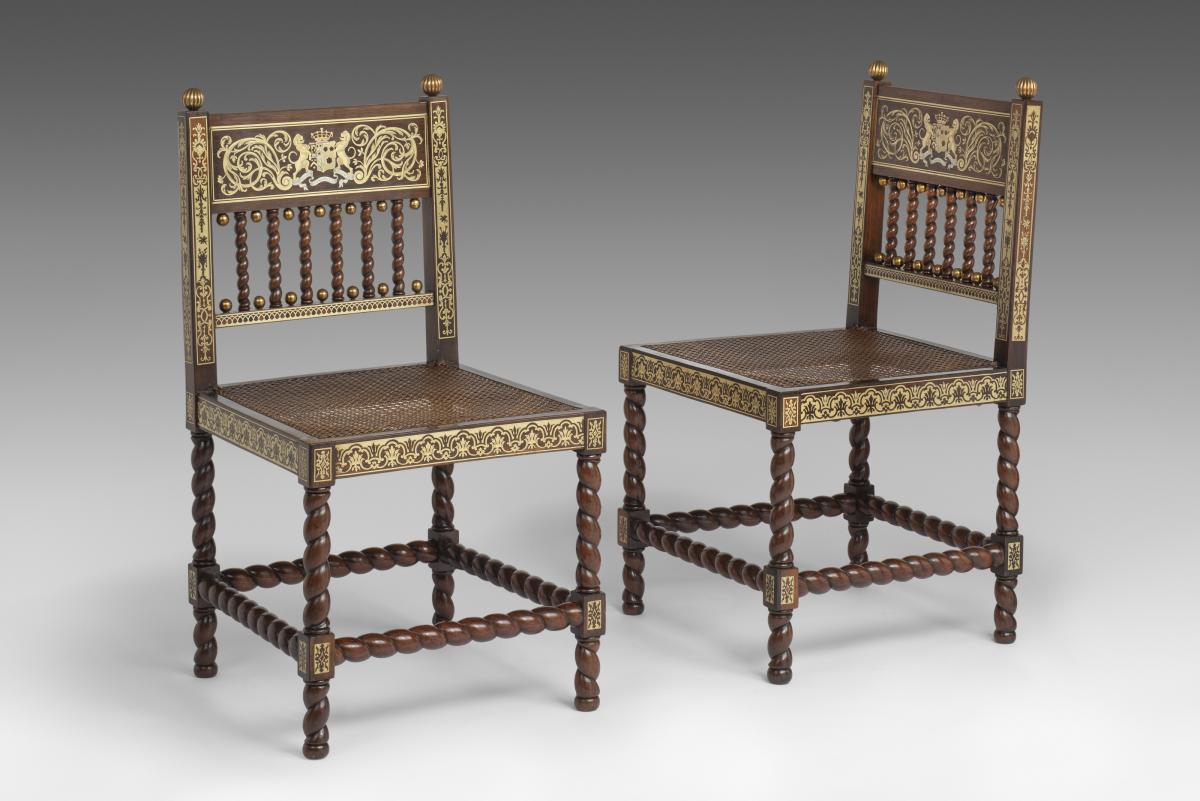
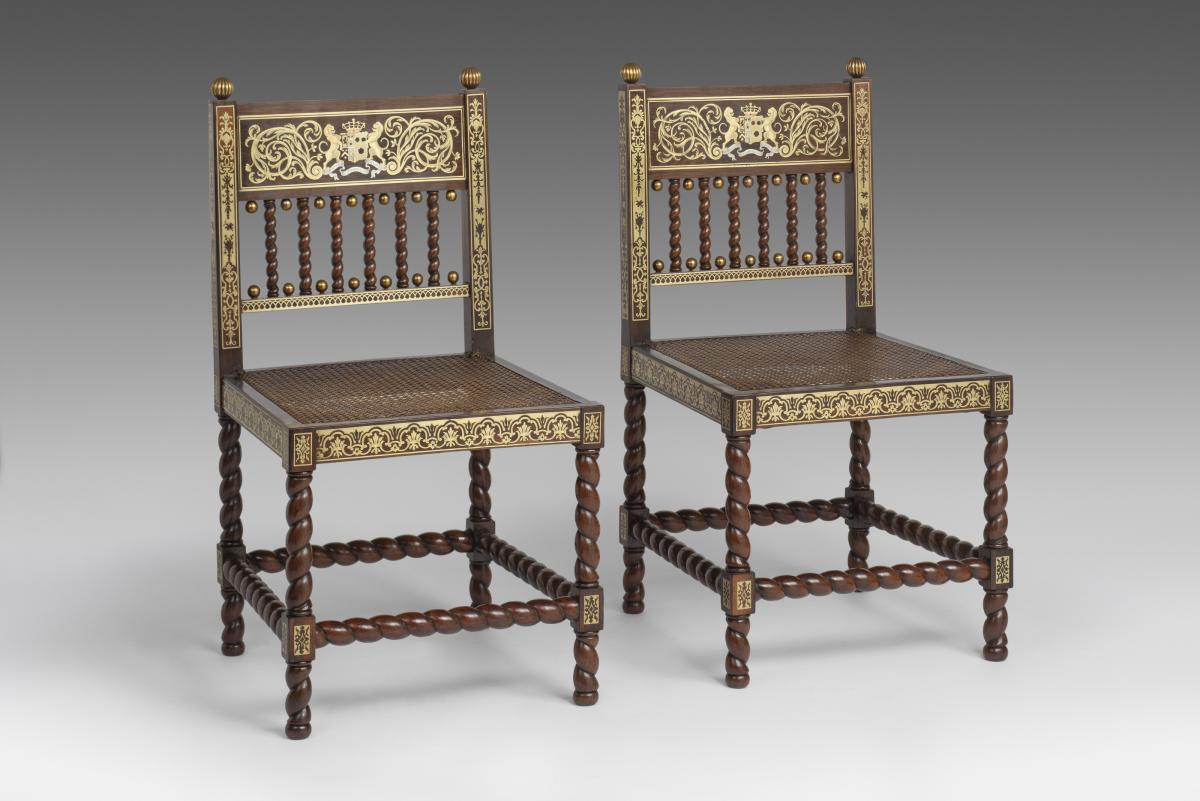
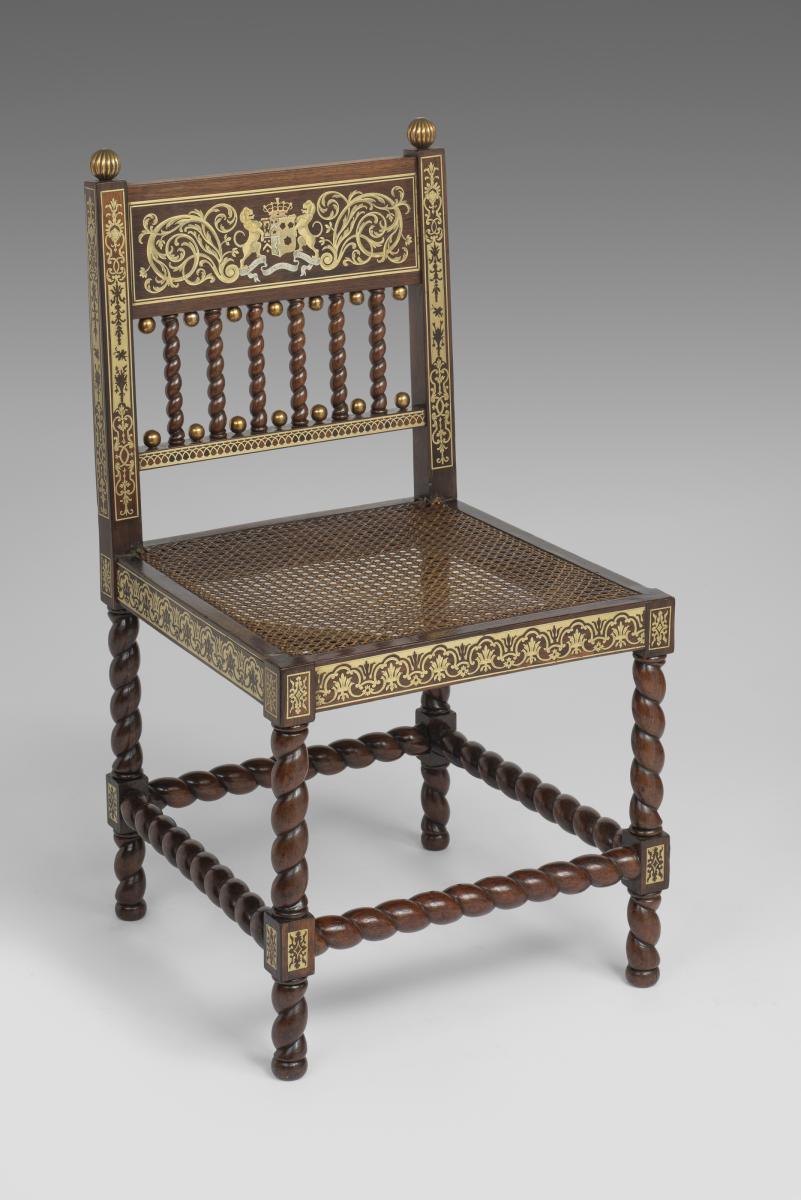
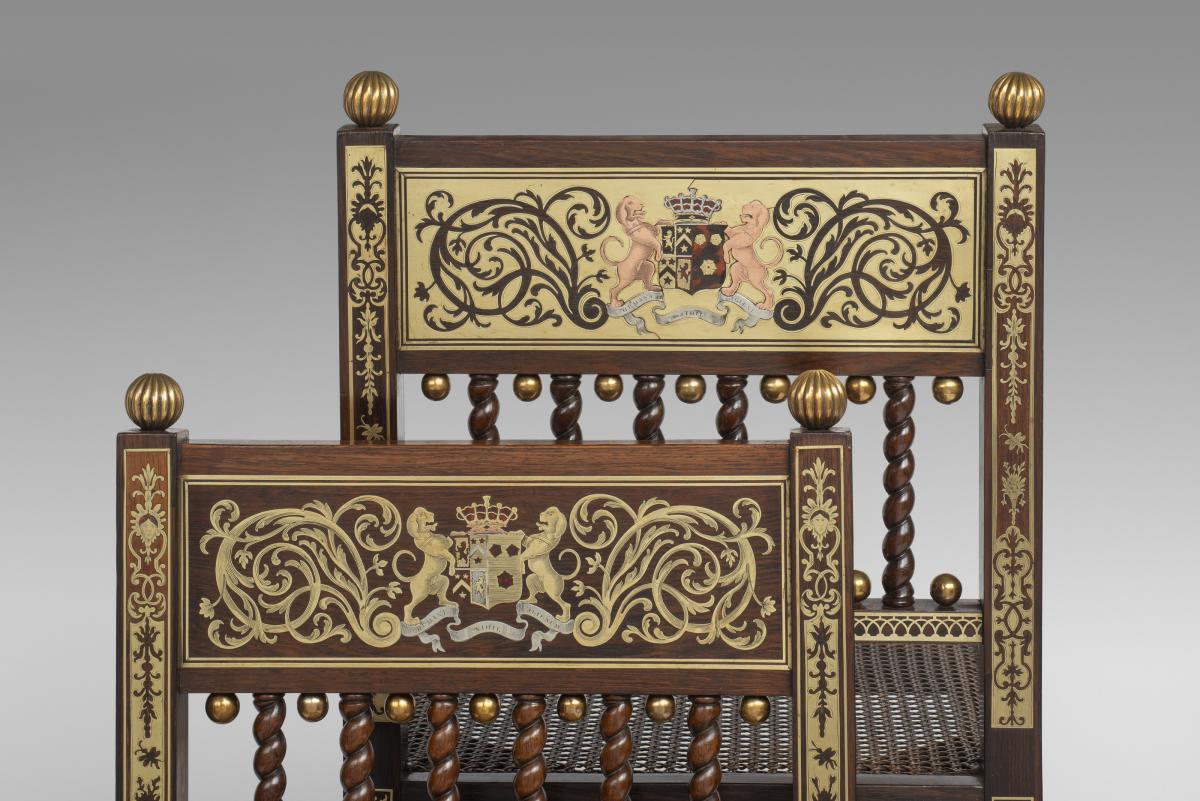
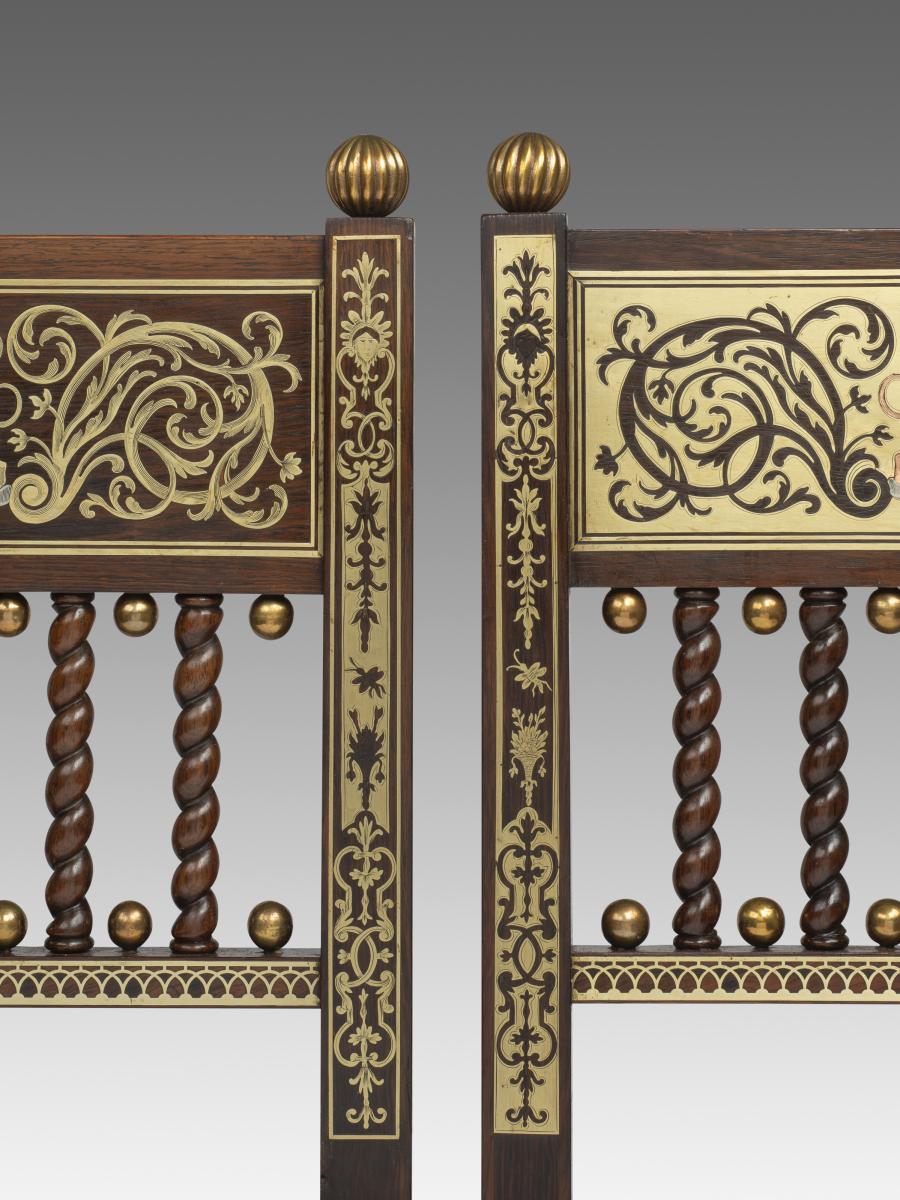
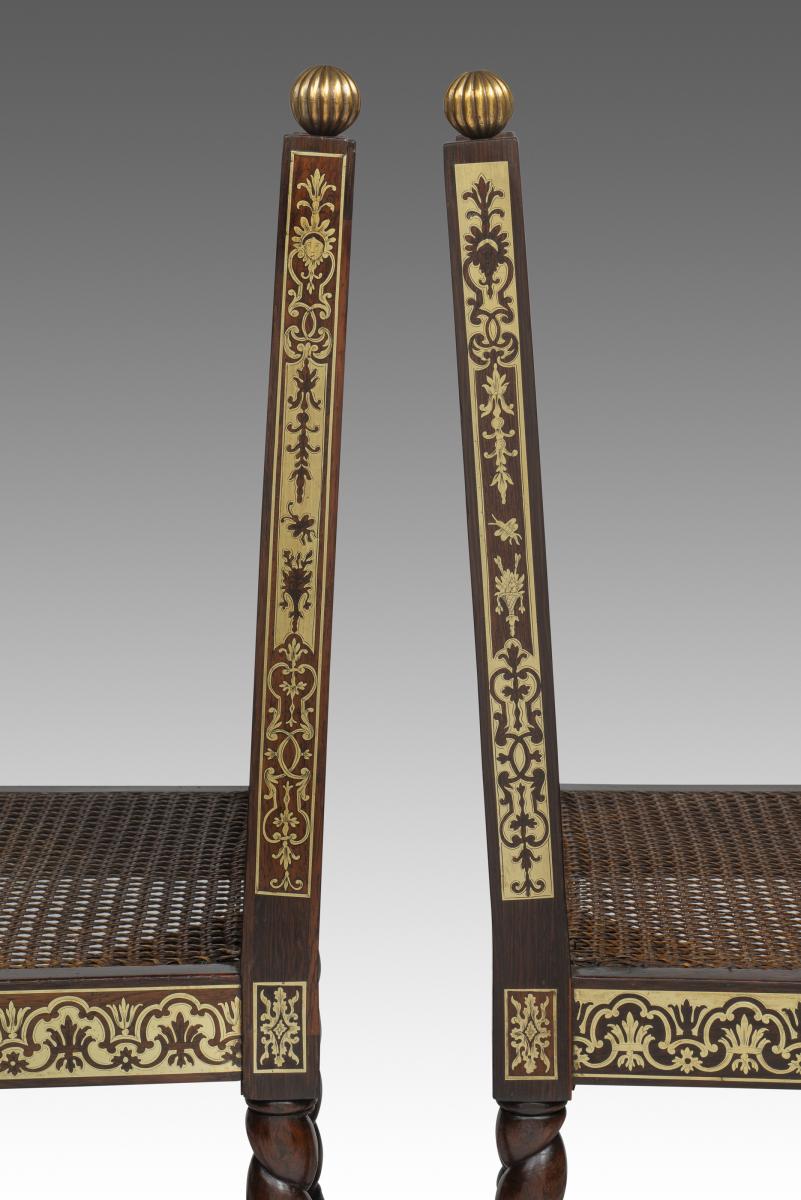
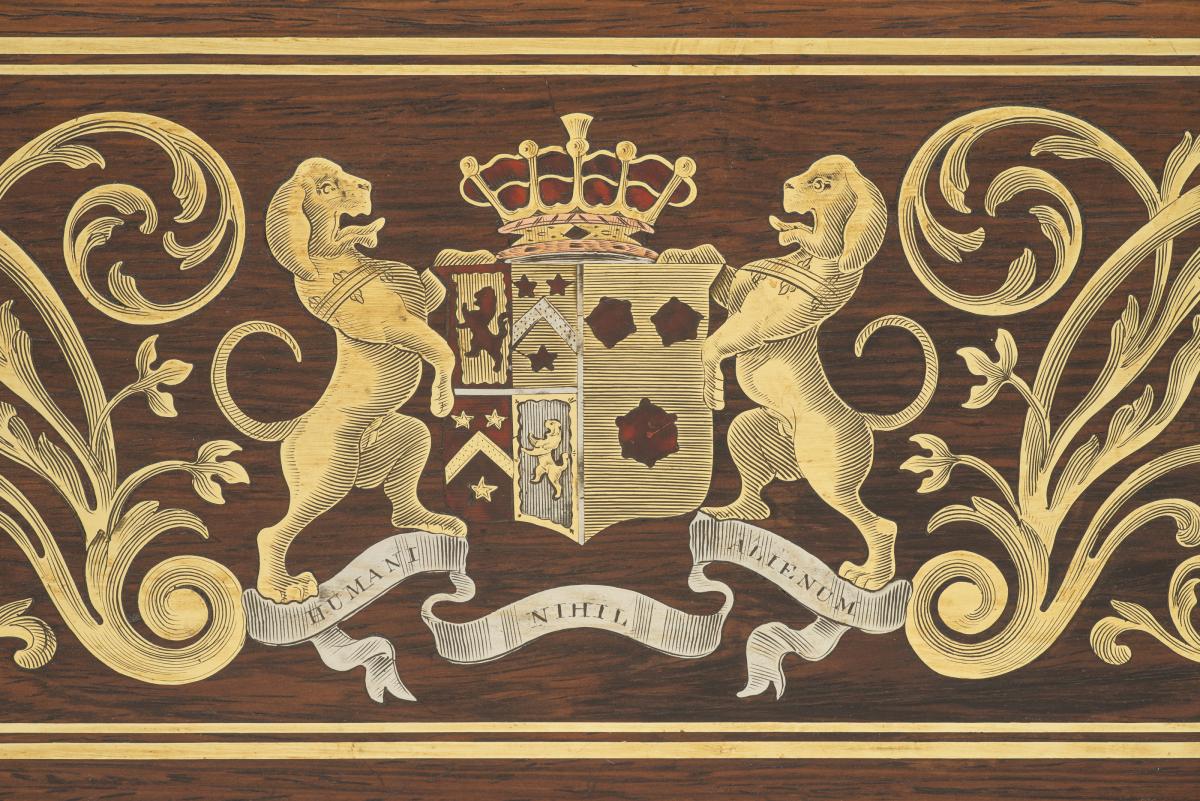
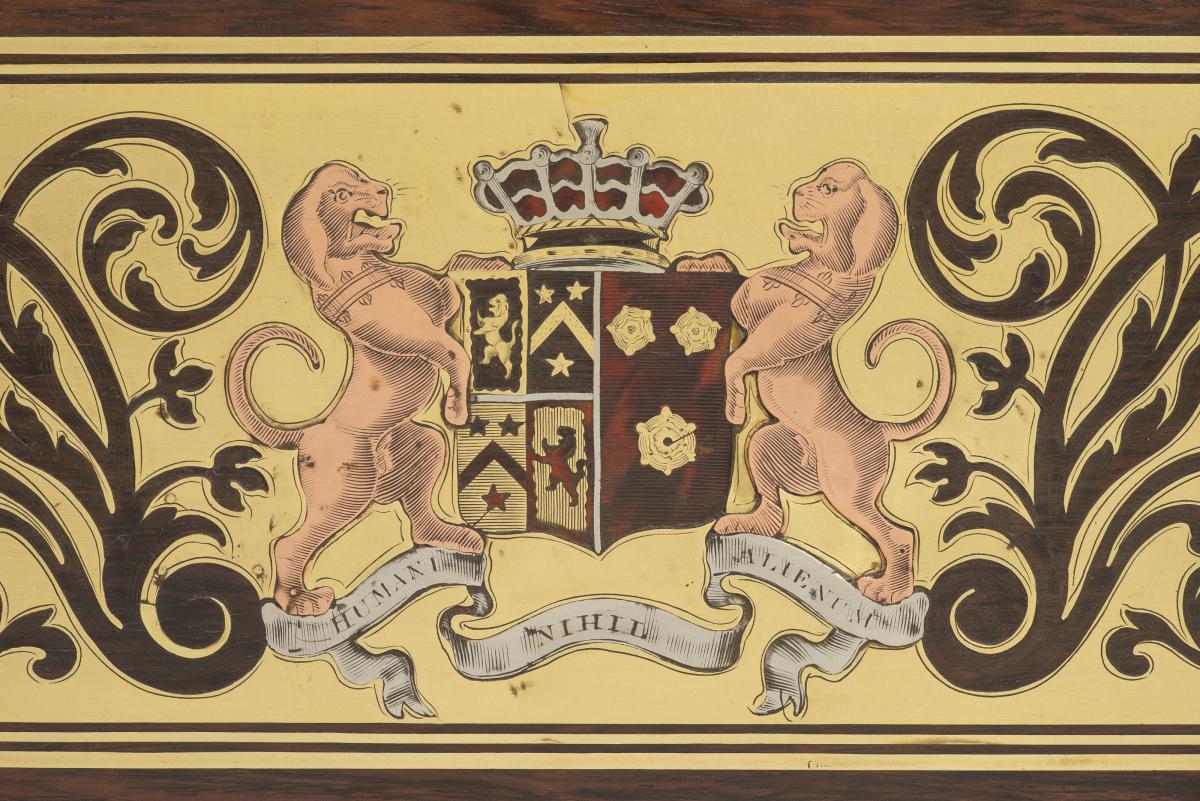
Price on application
This object includes complimentary, Insured Shipping / Delivery within the UK
This object is eligible for a Certificate of BADA Provenance
The BADA Standard
- Since 1918, BADA has been the leading association for the antiques and fine art trade
- Members are elected for their knowledge, integrity and quality of stock
- Our clients are protected by BADA’s code of conduct
- Our dealers’ membership is reviewed and renewed annually
- Bada.org is a non-profit site: clients deal directly with members and they pay no hidden fees
Pair of Regency Rosewood and 'Buhl' Marquetry Antiquarian Side Chairs.
England, Circa 1810-15.
Provenance:
Commissioned by the 2nd Earl Talbot of Hensol (1777 – 1849) circa 1810-15, of Ingestre Hall, Staffordshire
3rd Earl Talbot of Hensol and 18th Earl of Shrewsbury (1803 – 1868) at Ingestre
4th Earl Talbot of Hensol and 19th Earl of Shrewsbury (1830 -1877) at Ingestre
5th Earl Talbot of Hensol and 20th Earl of Shrewsbury (1860 – 1921) at Ingestre
6th Earl Talbot of Hensol and 21st Earl of Shrewsbury (1914 – 1980) at Ingestre until the Hall was sold in 1960
7th Earl Talbot of Hensol and 22nd Earl of Shrewsbury, Staffordshire
Solid rosewood, mahogany, rosewood veneer, lacquered brass, copper, pewter, tortoiseshell, and caning.
The chairs offered here are a rare example of Antiquarian taste in English Regency furniture also incorporating première and contre-partie ‘buhl’ marquetry in the French ancien regime style.
The antiquarian form
The form of these chairs is inspired directly by the form of a ‘back stool’ which dominated chair designed in 17th Century England. Literally a stool with a back; the legs are straight with no rake or shaping, with low stretchers all around for strength. This rigid, rectilinear form was in stark contrast to the various fashions in the 18th Century for cabriole and later swept legs, and appeared simpler and earlier in date. Equally the rope-twist turned decoration on the legs, stretchers and spindles is a direct reference to 17th Century design. This antique taste is often associated with the antiquarian, art collector and novelist, Horace Walpole (1717-97), who, in addition to having an ‘imaginative engagement with the past’, strove for the ‘authentic’ historical object and for quality craftsmanship in his antiquarian purchases (Davis, p. 28). Amongst the furniture he acquired for Strawberry Hill were some 17th Century Anglo Indian ebony chairs which Walpole believed to be English from the Tudor period (based on similar chairs he had seen at Esher Place which had previously been owned by Cardinal Wolsey). It is striking how similar the form of the Talbot chairs is to the Walpole ebony chairs; while both are clearly derived from the English 17th Century prototype it is tempting to wonder if the designer of the Talbot chairs was influenced by Walpole’s Anglo-India versions (see image of Anonymous engraving of an Ebony Chair Formerly Belonging to Horace Walpole at Strawberry Hill [Accession no. LDORL : 00230, Ionides Collection, Orleans House Gallery, Twickenham])
In 100 British Chairs (Adam Bowett p.74) Walpole’s antiquarianism is noted as ‘an intellectual novelty’ and that the ‘next generation included the fabulously wealthy William Beckford (1760-1844) and the Scottish writer Sir Walter Scott (1771-1832)’. The emergence of these chairs, which are being offered for sale for the first time since they were made, adds another important antiquarian patron to their number. The precise details of the commission remain unknown, but it is clear that Charles Chetwynd Talbot, 2nd Earl Talbot, was an aesthete and an antiquarian with a great interest in improving his ancestral home who considered this antiquarian design appropriate for furnishing ancient interiors like the Jacobean rooms at Ingestre Hall (Wainwright, p. 251). Ingestre Hall was a Jacobean mansion built by Earl Talbot’s ancestor, Sir Walter Chetwynd (d. 1638), in 1613. Considerable alterations were made to Ingestre during Earl Talbot’s tenure. Between 1808-1813 and 1817-1821, John Nash (1752-1835), one of the foremost British architects of the Georgian and Regency eras, remodelled parts of the exterior and interior. Nash’s ‘Elizabethan’ style was seemingly ‘loyal in spirit and detail’ to the original Jacobean mansion, and the chairs offered here must surely have been intended to complement the Elizabethan interiors (Summerson, p. 50).
Unfortunately, there is little detailed knowledge of Nash’s work at Ingestre; a great fire in 1882 gutted much of the interior, including the muniment room, and the state room floor fell through to the grand hall below. Notwithstanding, his proposed design for the north front of Ingestre Hall to correspond with the south front is in the Soane Museum, London; this added several rooms and a grand staircase (73/5/4). He is also credited with re-designing the west front, and having replaced the Jacobean cupola on the South Front by an open lantern standing on an observation platform, which copied one at Hatfield House, Hertfordshire, the much admired seat of Earl Talbot’s uncle, the Marquess of Salisbury (Andrews, p. 12).
Earl Talbot would have been aware of the importance of the historic origins of the Chetwynd family at Ingestre, who were settled there from at least the end of the 13th century. The neighbouring church was designed by Sir Christopher Wren in the late 17th century, and in the mid-18th century, ‘Capability’ Brown was commissioned to make improvements to the parkland. Throughout his career, Earl Talbot received a number of artistic honours: he was made FRS (Fellow of the Royal Society) and FSA (Fellow of the Society of Antiquaries) in May 1813. He inherited a valuable collection of books including five volumes in manuscript collected by Sir Walter Chetwynd’s grandson, also Walter (1633-93), an antiquary, historian and politician, comprising letters and pedigrees, together with a large number of family portraits (Hall, p. 3). Earl Talbot was also responsible for commissioning the magnificent silver and silver gilt collection displayed in the Dining Room in 1957, which includes a massive silver-gilt centre piece dated 1818, and a gilt tankard surmounted by a greyhound by the renowned silversmith Paul Storr (Lowther, plates 17 and 18; opp. plate 23). Furthermore, in October 1828, he invited Sir Uvedale Price, 1st Baronet, and author of Essay on the Picturesque, As Compared with the Sublime and The Beautiful (1794), to advise him in a professional capacity on the picturesque landscape at Ingestre (Watkins, Cowell, p. 60).
There are other notable examples of patrons seeking chairs of antiquarian taste in the early 19th Century (?). The novelist Sir Walter Scott, who served as a vice president of the Society of Antiquaries of Scotland (1827-1829) was regarded, along with his architects William Atkinson and Edward Blore, as a pioneer of the Scottish Baronial style of architecture. His house at Abbotsford is festooned with turrets and stepped gabling and he commissioned Richard Bridgens to design a chair in the Gothic manner (see design at the V&A Accession no. E.758-1982). The V&A also hold an example of the design executed for Sir Godfrey Vassal Webster by George Bullock (V&A Accession no. W.53-1980).
Fellow antiquarian, William Beckford (1760-1844), later appears to have purchased six of the Esher Place chairs for Fonthill Abbey, Wiltshire, like Walpole believing they were ‘Tudor’ and originally the property of Cardinal Wolsey (ibid., p. 254).) Chairs of similar form to the present chairs were described in the 1836 Ashmolean Museum catalogue as: ‘Two chairs, the backs of which are of ebony and beautifully carved. They were presented to the Founder of the museum by king Charles II’. More recently, they have been identified as having been made on the Coromandel Coast in India, and there is no evidence of a Royal connection (Wainwright, p. 250; Ashmolean, EA2022.158 and 159). Henry Shaw described (and illustrated) the Ashmolean chairs the same year in his Specimens of Ancient Furniture (plate XII): ‘The spiral carving in the legs and backs is characteristic of the time, and the little elevation of the back proves it to be an example appertaining to the earlier part of his [Charles II] reign’ (Shaw, p. 32). Specimens of Ancient Furniture was influential in the formation of the ‘Old English’/antiquarian style of the early to mid-19th century, ‘which gave detailed drawings of English furniture in private possession, ranging from the few medieval survivals to late seventeenth century pieces…’ (Aslin, p. 30).
18th Century French Boulle marquetry and its revival in Regency England, ‘buhl’ inlay, became highly fashionable due in large part to the passion of the Prince Regent (later George IV) for all forms of French decorative art (Kirkham, p. 416). Between 1802 and 1803, a temporary resumption of trade between England and France during the Treaty of Amiens saw an influx of British visitors to Paris buying French decorative arts from the Paris sales. In the same period, the London auction houses were advertising sales of consignments from Paris (Davis, p. 49). After the fall of Napoleon, collectors of French 18th century boulle furniture including the Prince Regent, the Duke of Wellington (1769-1852) at Stratfield Saye, Hampshire, and the 3rd Marquess of Hertford, styled Earl of Yarmouth between 1794 and 1822, at Ragley Hall, Warwickshire, employed agents in Paris to buy on their behalf from the Paris auctions of 1816-17 and arrange shipment of the artworks back to Britain (Jourdain, p. 203).
The demand for intricate buhl inlay saw the emergence of a limited number of ‘manufactories’ specialising in buhl work or craftsmen that could be classified as ‘good buhl cutters’, that is, those able to ‘design and cut their own patterns from engravings and other sources’, and such craftsmen were based solely in London (Kirkham, p. 419). The most celebrated of those was Thomas Parker (fl. 1805-34) of 19 Air Street, Piccadilly, who styled himself, ‘Cabinet & Buhl Manufacturer to H.R.H. the Prince Regent and Royal Family’. It is interesting to note the similarity of the buhl inlay decoration on the vertical end panels of these chairs to buhl inlay borders found on a pair of commodes supplied by Parker in 1812 to the 2nd Marquess of Bath for the Saloon at Longleat, Wiltshire (Cator, p. 226, figs. 1 and 2). The Longleat commodes are a combination of 18th century boulle and buhl inlay with Parker supplying the closely related buhl borders. His invoice describes the commodes as follows:
‘Makeing two New Cabinetts / With Buhl Ends Pillasters Borders / legs and strechers
With Brass Caps / Socketts feet & Using the Old / Drawer fronts Ceader Dawers ¡sic]
With Brass Molding at 44-10 each’ (ibid., pp. 225-226).
Parker also reproduced original Boulle models, for example, a pair of première-partie coffers supplied to the 6th Duke of Bedford for Woburn Abbey, Bedfordshire, and their companion pair in contre-partie supplied to George IV by Lord Yarmouth in January 1813 (RCIN 21624), and, as in the case of the Longleat commodes, he applied his own buhl inlay to Regency furniture forms and reused 18th century Boulle panels in new furniture (Davis, p. 160). Parker’s buhl work may have been undertaken by ‘in-house’ inlayers or alternatively outsourced to journeymen émigré marqueteurs. The Royal Collection includes several pieces of buhl furniture by Parker: a contre-partie vitrine table (RCIN 177) - its première-partie pair sold at Christie’s in 1987; a contre-partie pair of coffers on stands (RCIN 1813) and a pair of première-partie and contre partie drum-shaped tables (RCIN 33461).
The other equally-renowned buhl craftsman working in Regency London was Louis-Constantin Le Gaigneur (fl. c. 1814-21), who probably trained in his native country, and is first recorded in 1814-15 at the Buhl Manufactory at 19 Queen Street (now Harrowby Street) London (Levy, p. 179). Le Gaigneur’s most important patron, similarly to Parker, was the Prince Regent at Carlton House, Piccadilly. In July 1815, he delivered ‘A Very handsome Metalic Buhl ornament Library Table composed of 3 various metals in Devices…’ and ‘A handsome Metalic Buhl ornament Table’, a companion to the former, both of which were sent to the Royal Pavilion in Brighton – now in the Queen’s Ballroom, Windsor Castle (RCIN 35289) (Levy, pp. 180-181, figs. 8-9). A table in the Regent’s Gallery at Belvoir Castle, Leicestershire, and a writing table in the Wallace Collection, London (F.4791) are closely related to those at Windsor, and must have been supplied by Le Gaigneur (ibid., p. 180). The magnificent buhl inlay on a fine brass-inlaid pier commode or cabinet, attributed to Gillow & Co., Oxford Street, c. 1820-1830, may have been contracted out to Le Gaigneur (Stuart, vol. II, pp. 17-18) (see . https://www.coulborn.com/artworks/categories/9/1633-regency-rosewood-and-brass-inlaid-cabinet/)
Charles Chetwynd Talbot, 2nd Earl Talbot and Ingestre Hall, Staffordshire
The coat of arms on this magnificent pair of Regency antiquarian chairs rendered in both première and contre partie buhl inlay represent the arms of Charles Chetwynd Talbot, 2nd Earl Talbot of Hensol (1777-1849) impaling the arms of his wife Frances Thomasine Lambert (1782-1819), eldest daughter of Charles Lambert of Beau Parc in County Meath, Ireland. A design for a set of hangings bearing the same Talbot arms by the furniture maker, Gillows of Lancaster & London, is in the Victoria & Albert Museum, London (E.98-1952).
The 2nd Earl Talbot was the eldest son of John Chetwynd Talbot, 1st Earl, and his wife, Charlotte, daughter of Wills Hill, 1st marquess of Downshire. He succeeded to the peerage and to the Ingestre Hall estate in Staffordshire at the death of his father in 1793 when he was just sixteen years old. After graduating in 1797 with an M.A. from Christ Church, Oxford, he joined Lord Whitworth’s embassy in St. Petersburg, Russia, as a voluntary attaché. Upon his return to England, in 1800, he married Frances Thomasine Lambert, and focussed on the improvement of his estates and the general promotion of agriculture in England. In this, he was probably inspired by his wife’s uncle, Thomas Coke, 1st Earl of Leicester (1754-1842) of Holkham Hall, Norfolk, a renowned agricultural reformer. In 1803, Earl Talbot took an active part in raising a volunteer force in Staffordshire to thwart a possible Napoleonic invasion. From 1812 until his death in 1849, he held the posts of Lord Lieutenant and Custos Rotulorum (Keeper of the County Records) of the County of Stafford, and, in 1839, received a testimonial of £1,400 in recognition of his services – an amount he used for the endowment of a new church at Salt. In 1817, Earl Talbot was appointed Lord Lieutenant of Ireland (1817-1821) and took up residency for some of the time in the state apartments at Dublin Castle. In Ireland, he continued his patronage of agriculture. In 1821, George IV made his first and only visit to Ireland, and created Earl Talbot a knight of the Order of St Patrick. Earl Talbot was a supporter of Sir Robert Peel’s Conservative government, and in 1844, Peel recommended that he be made a knight of the Garter.
We are grateful to Sharon Goodman for her assistance with this description.
Conservation: Report on conservation work by Yannick Chastang available on request.
COMPARATIVE LITERATURE (in publication date order):
H. Shaw, Specimens of Ancient Furniture, London, 1836, p. 32 and plate XII.
‘Obituary’, The Gentleman’s Magazine, 1849, pp. 313-315.
S.C. Hall, The Baronial Halls and Ancient Picturesque Edifices of England, vol. I, London, 1858, ‘Ingestrie Hall’, pp. 1-4.
‘Destruction of Ingestre Hall by Fire’, The Builder, 21 October 1882, p. 543.
M. Jourdain, ‘Stratfield Saye, Hampshire: Some Furniture and Treasures of the First Duke of Wellington’, Country Life, 28 January 1949, pp. 202-203.
‘Ingestre Hall opens its doors’, The Sphere, 5 May 1956, p. 164.
G. Lowther, Ingestre Hall guide book, Derby, 1957.
G. Nares, ‘Ingestre Hall, Staffordshire – I’, Country Life, 17 October 1957, pp. 772-775; II, 24 October 1957, pp. 874-877; III, pp. 924-927.
E. Aslin, Nineteenth Century English Furniture, London, 1962, p. 30.
J. Summerson, The Life and Work of John Nash: Architect, Cambridge, Mass., 1980, p. 50.
P. Kirkham, ‘Inlay, Marquetry and Buhl Workers in England c. 1660-1850’, The Burlington Magazine, June 1980, pp. 415-419.
C. Wainwright, ‘Only the True Black Blood’, Furniture History, 1985, pp. 250-257.
M. Levy, ‘Sincerest Form of Flattery’, Country Life, 15 June 1989, pp. 178-181.
C. Morley, ‘The Revival of “Old English” style in Nineteenth Century Furniture’, The Journal of the Decorative Arts Society 1850-the Present, 1992, pp. 20-23.
F. Collard, ‘Town & Emanuel’, Furniture History, 1996, pp. 81-89.
C. Cator, ‘Thomas Parker at Longleat’, Furniture History, 1997, pp.
C. Watkins, B. Cowell, ‘Letters of Uvedale Price’, The Volume of the Walpole Society, 2006, p. 60.
S. Stuart, Gillows of Lancaster and London, Woodbridge, 2008, vol. II, pp. 17-18.
A. Andrews, A Short History of Ingestre, Tixall, 2013.
D. Davis, The Tastemakers: British Dealers and the Anglo-Gallic Interior, 1785-1865, Los Angeles, 2020.
Oxford Dictionary of National Biography, https://doi.org/10.1093/ref:odnb/26924. Accessed 16 January 2024.
Dimensions
93.25 x 49.5 x 49 cmPrice on application
This object includes complimentary, Insured Shipping / Delivery within the UK
This object is eligible for a Certificate of BADA Provenance
Stock number
7050The BADA Standard
- Since 1918, BADA has been the leading association for the antiques and fine art trade
- Members are elected for their knowledge, integrity and quality of stock
- Our clients are protected by BADA’s code of conduct
- Our dealers’ membership is reviewed and renewed annually
- Bada.org is a non-profit site: clients deal directly with members and they pay no hidden fees


